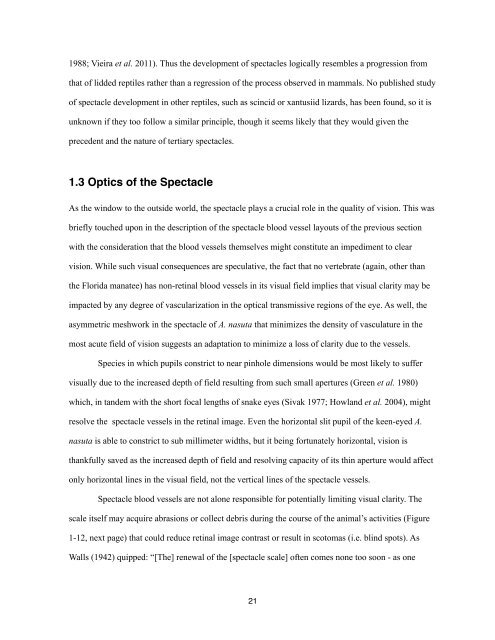Chapter 1, The Reptilian Spectacle - UWSpace - University of ...
Chapter 1, The Reptilian Spectacle - UWSpace - University of ...
Chapter 1, The Reptilian Spectacle - UWSpace - University of ...
You also want an ePaper? Increase the reach of your titles
YUMPU automatically turns print PDFs into web optimized ePapers that Google loves.
1988; Vieira et al. 2011). Thus the development <strong>of</strong> spectacles logically resembles a progression from<br />
that <strong>of</strong> lidded reptiles rather than a regression <strong>of</strong> the process observed in mammals. No published study<br />
<strong>of</strong> spectacle development in other reptiles, such as scincid or xantusiid lizards, has been found, so it is<br />
unknown if they too follow a similar principle, though it seems likely that they would given the<br />
precedent and the nature <strong>of</strong> tertiary spectacles.<br />
1.3 Optics <strong>of</strong> the <strong>Spectacle</strong><br />
As the window to the outside world, the spectacle plays a crucial role in the quality <strong>of</strong> vision. This was<br />
briefly touched upon in the description <strong>of</strong> the spectacle blood vessel layouts <strong>of</strong> the previous section<br />
with the consideration that the blood vessels themselves might constitute an impediment to clear<br />
vision. While such visual consequences are speculative, the fact that no vertebrate (again, other than<br />
the Florida manatee) has non-retinal blood vessels in its visual field implies that visual clarity may be<br />
impacted by any degree <strong>of</strong> vascularization in the optical transmissive regions <strong>of</strong> the eye. As well, the<br />
asymmetric meshwork in the spectacle <strong>of</strong> A. nasuta that minimizes the density <strong>of</strong> vasculature in the<br />
most acute field <strong>of</strong> vision suggests an adaptation to minimize a loss <strong>of</strong> clarity due to the vessels.<br />
Species in which pupils constrict to near pinhole dimensions would be most likely to suffer<br />
visually due to the increased depth <strong>of</strong> field resulting from such small apertures (Green et al. 1980)<br />
which, in tandem with the short focal lengths <strong>of</strong> snake eyes (Sivak 1977; Howland et al. 2004), might<br />
resolve the spectacle vessels in the retinal image. Even the horizontal slit pupil <strong>of</strong> the keen-eyed A.<br />
nasuta is able to constrict to sub millimeter widths, but it being fortunately horizontal, vision is<br />
thankfully saved as the increased depth <strong>of</strong> field and resolving capacity <strong>of</strong> its thin aperture would affect<br />
only horizontal lines in the visual field, not the vertical lines <strong>of</strong> the spectacle vessels.<br />
<strong>Spectacle</strong> blood vessels are not alone responsible for potentially limiting visual clarity. <strong>The</strong><br />
scale itself may acquire abrasions or collect debris during the course <strong>of</strong> the animal’s activities (Figure<br />
1-12, next page) that could reduce retinal image contrast or result in scotomas (i.e. blind spots). As<br />
Walls (1942) quipped: “[<strong>The</strong>] renewal <strong>of</strong> the [spectacle scale] <strong>of</strong>ten comes none too soon - as one<br />
21
















